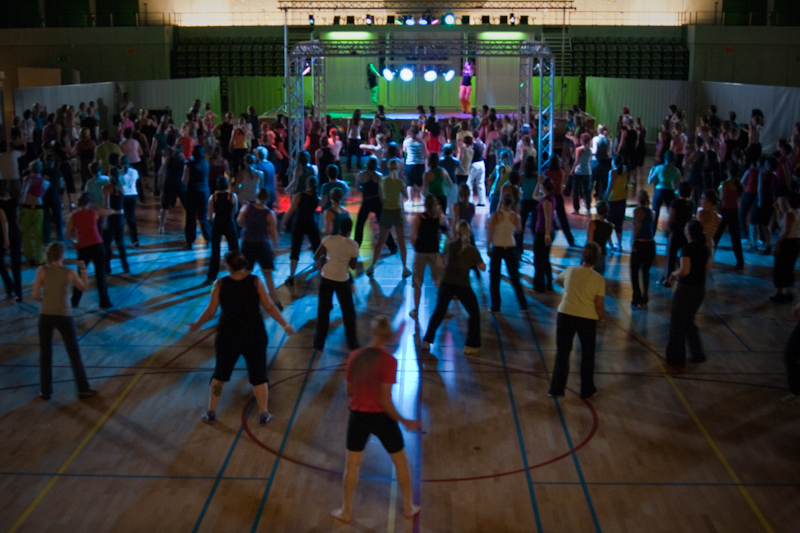
Exercising for Weight Loss: What’s the Right Frequency?
If you’re trying to lose weight, you may have heard that exercise is key. But how often should you exercise for maximum weight loss? In this article, we’ll look into the right frequency for exercising to boost your weight loss plan. Let’s explore!
List of Content
- 1. Why Frequency Matters in Weight Loss Exercising
- 2. Setting Goals – How Many Workouts A Week?
- 3. Picking The Right Frequency For You
- 4. Balancing Your Workouts – Variety Is Key!
- 5. Benefits of Working Out A Lot
- 6. Exercising Safely For Optimal Weight Loss Results
- You Ask, I answer

1. Why Frequency Matters in Weight Loss Exercising
The frequency of your exercise routine can often be just as important as the intensity of your workouts when it comes to weight loss. Working out consistently is essential for creating a habit, and for realizing visible results. Here are reasons why frequency is essential for successful weight loss exercising:
- Makes Exercise a Habit: If you’re regularly hitting the gym, running on the treadmill, or doing jumping jacks every day, it will quickly become a part of your practice and lifestyle. Frequency and repetition lay the groundwork for changing your behavior, transforming your thoughts and attitude as well as your body.
- Develops Endurance: It can take weeks or months before you experience stronger muscles, better stamina, and improved endurance from exercising. Working out regularly improves your strength, endurance, and fitness level, which helps you go further and perform better in every training session.
- Increases Your Metabolism: Increasing your activity level forces your body to burn calories faster to keep up with your increased needs for energy. As you exercise more often, your metabolism and energy levels naturally rise, letting you burn fat and tone your muscles far more efficiently.
- Boosts Motivation: Seeing the results of your regular workouts can give you extra motivation to keep up your fitness routine. Don’t forget that every small step you take helps you reach your desired destination.
By now, you realize the importance of frequency in your weight-loss success. You need to regularly repeat exercises for a long enough period of time to experience the health benefits of your fitness journey. So, make sure you are consistent with your exercise sessions to get the most out of your fitness journey.
Keep track of your progress on a daily, weekly, or monthly basis. Evaluating the frequency of your workouts can help you determine if you’re accomplishing your fitness goals. Always use frequency as your point of reference when creating a fitness plan – this can transform the way you look and feel.

2. Setting Goals – How Many Workouts A Week?
It’s important to set measurable goals for fitness success. Whether you’re already in shape or just starting out on your journey, having goals will help you stay motivated and stay on track. Here are some ideas for how many workouts a week to aim for.
Start Slow:
- If you’re new to working out, aim for two to three work outs a week. These can be short sessions of 15-30 minutes depending on your goals.
- This will help build up your fitness and endurance without burning yourself out.
Regular Exercise:
- If you already have a regular fitness routine, aim for four to five workouts a week. This could be anything from weight training to a run.
- This level of exercise will help maintain your current level of fitness.
Serious Goals:
- If you are aiming to make serious gains or make dramatic improvements in your strength and fitness, aim for five to seven workouts a week.
- This will require a high level of dedication and can often tire you out so make sure to get adequate rest.
3. Picking The Right Frequency For You
When it comes to choosing a frequency for your skin care regime, there are a few things to consider. First, it’s important to consider your skin type. If you have dry or sensitive skin, you may need to use a product every other day or once per week. Oily skin may require a more regular routine. Give your skin time to adjust to a new routine and to see how it responds.
What type of product are you using? The type of product you choose is also important. Cleansers and toners do not need to be used daily- once or twice per week should be sufficient. Exfoliants may trigger sensitivity or dry your skin- use once or twice per week, or as recommended.
When is the best time?
It is also important to consider the best time to use the product. If you are using a retinol, for example, it is best to use it in the evenings. This is because retinols can make your skin photosensitive, so you should not use it during daylight hours. Similarly, certain toners or astringents should not be used prior to makeup.
Tips for routine
- Consider your skin type and select products accordingly.
- When you’re getting started, begin with using the product once or twice per week, and adjust your routine as needed.
- Be mindful of the time of day-certain products should be used at certain times.
- Listen to your skin- if it’s responding poorly to a routine, change it up.
4. Balancing Your Workouts – Variety Is Key!
The key to a balanced and effective workout routine is to always make sure to include a variety of exercises and workouts. We recommend focusing on the following during each of your weekly workouts:
- Strength Training: Include weight-training exercises of all types, such as squats, deadlifts, presses, and rows, which will help to increase your muscle mass and bone density.
- Flexibility: Take part in static stretching exercises to maintain your stretching ability and prevent injury.
- Cardio Workouts: Incorporating cardio exercises such as running, cycling, swimming, and rowing helps to keep your cardiovascular health at its best.
- Core Training: Working your core muscles is essential for maintaining stability and developing a strong midsection.
Rather than focusing solely on one type of exercise, try to include a combination of exercises when creating your workout routine. This will ensure you get a balanced workout and maximize the benefits of training. For example, if you are focusing on strength training, include a stretching session and some cardio in the same workout session.
Keep in mind that mixing up your workouts keeps your body from plateauing. You should aim to switch up your routine regularly to keep your muscles guessing and adapting. Being creative with your exercise program is essential for maintaining an effective and balanced workout routine.
At the same time, focus on setting realistic goals for yourself during each workout session and improving your technique. Progressively challenging yourself to try harder exercises and increase intensity will help to keep you motivated and track your progress over time. Balancing your workouts is also important for avoiding boredom and burnout so you can enjoy the process.
5. Benefits of Working Out A Lot
Improved Cardiovascular Health. Regular exercise strengthens your heart muscles, lowers your risk of heart disease and stroke, and helps you maintain a healthy weight and blood pressure. Performing endurance exercises such as jogging, running, or team sports helps to:
- Strengthen your heart
- Improve blood flow
- Increase your body’s use of oxygen
Stronger Muscles. If you are exercising regularly it strengthens the muscles in your body. This in turn is important for balance, body coordination, core stability, and for our daily activities such as lifting, bending, walking, and climbing stairs. Strength training helps you build muscle and reduce fat.
Joint Benefits. Working out regularly strengthens muscles that support your joints, decreases risk of injury, and helps relive stiffness and joint pain. Exercise can also promote healthy cartilage and muscles surrounding your joints and removes toxins that can affect your joints.
Mental Health Benefits. Regular exercise can improve your mental health by reducing stress and anxiety and improving your mood. Exercise is also known to reduce risk of developing depression. Exercise can also help to improve cognitive functions by increasing the brain’s plasticity, focus and ability to learn.
6. Exercising Safely For Optimal Weight Loss Results
When exercising for weight loss, safety is key. Although you may be motivated to quickly shed pounds, a proper warmup and cooldown are essential to prevent injury and promote more efficient results.
Start with a Warm Up: Whether you are doing aerobic or anaerobic exercise, always start with a warmup. Five to ten minutes of light cardio or dynamic stretching helps improve range of motion and reduce your risk for injury. Don’t forget to include a specific warmup for the muscles you will target throughout your exercise session.
Keep Good Posture: Proper posture is not only essential for avoiding injury, it also helps maximize your exercises. Keep your back straight and your chin up. If you are weightlifting, ensure that the weights don’t strain your arms by pulling them down. Additionally, when running or cycling, make sure to keep your back straight and look forward.
Take Rest Days: Even if you are exercising for weight loss, it’s important to take a rest day. This gives your muscles time to rebuild and strengthens your body. Additionally, rest days help your body stay in sync with your mind and enables you to stay motivated.
- Do 5-10 minutes of light cardio or dynamic stretching.
- Keep a straight back and chin up during exercise.
- Include specific warmups for target muscles.
- Take at least one day off per week for rest days.
Incorporating these simple tips into your exercise routine will help you create a safe and effective workout regimen, while optimizing your weight loss results.
You Ask, I answer
Q: What kind of exercise is best for weight loss?
A: The best kind of exercise for weight loss is High-Intensity Interval Training (HIIT), a form of exercise that alternates between periods of intense effort and periods of rest. HIIT is often considered the most effective, efficient and time-saving way to burn calories and boost metabolism.
Q: How often should I exercise to lose weight?
A: To maximize weight loss, you should exercise 3-4 times per week for about 30-45 minutes each session. If you can, try to mix up different types of workouts, such as cardio, strength-training and HIIT, to get the most out of your routine.
Q: Are there any other tips for exercising and weight loss?
A: In addition to taking your exercise regimen seriously, proper nutrition is also key to achieving your weight-loss goals. Eating healthy foods, such as lean proteins, fruits, vegetables, whole grains and healthy fats can help you maintain a balanced diet and support your workout routine.
Exercising at the right frequency is key when it comes to losing weight. With appropriate exercises and routine, you can achieve the desired results in no time. So, get up and give it a try. Your body will thank you in the long run!


